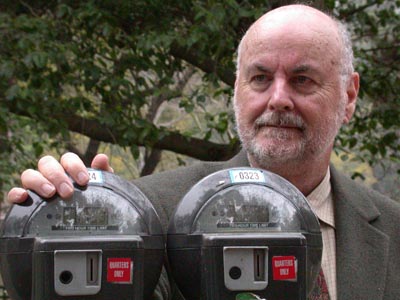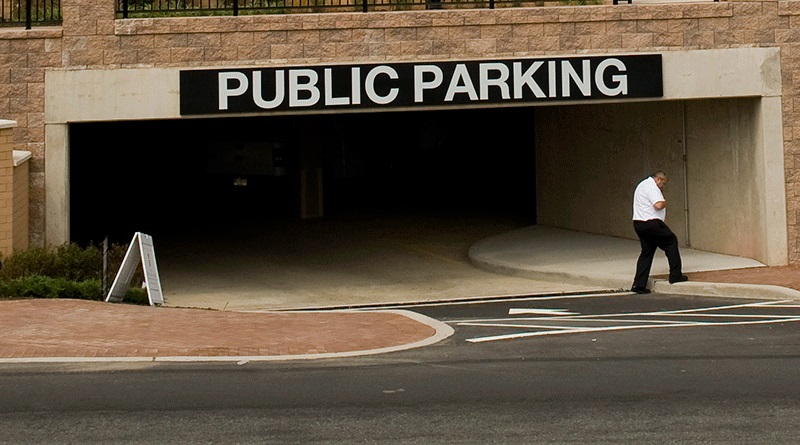There are basically four major areas that comprise the parking discussion: demand, design, financing, and management. We interviewed experts in each of these areas, asking them to spotlight major issues and possible solutions.
Demand
UCLA Professor Donald Shoup, author of the highly acclaimed book, The High Cost of Free Parking, believes the core problem is that towns require too much off-street free parking. Minimum parking requirements aimed at addressing observed peak demand creates excess parking with very negative consequences: waste of money, poor urban design, increase in impervious surface area and overuse of cars.

“Parking requirements thus impose cost on society to provide parking for cars, but planners do not estimate the subsidies for cars implicit in these parking requirements, or the effects on transportation and land use,” Shoup said. Unfortunately, planners receive little or no training in how to predict parking demand associated with various land uses. Instead, they rely on what nearby towns require, or use the ITE (Institute of Transportation Engineers) manual. If a community copies a neighbor’s parking standards, it is likely that mistakes just get repeated. Using ITE parking generation rates alone is flawed because these rates represent peak parking demand — measured at a few suburban sites with ample free parking and no public transit.
Shoup’s solution is to charge for parking regardless of who its serves — employees, shoppers or residents. He recommends three “pay or pave” strategies to reduce parking demand:
- Employer-paid transit passes. Many transit agencies offer “Eco-Passes” to employers. These passes give the employee the right to ride free anytime, not just for commuting to work. Because the employer buys passes for all employees (not just those who use transit regularly), the cost per pass is much lower than a regular pass. Studies have shown that when free transit passes are given to employees, transit share greatly increases and commuter parking demand decreases.
- Cash Out Option. The “cash out” option gives commuters the choice between free parking or its equivalent cash value. This arrangement effectively raises the price of commuter parking without charging for it.
- Car Sharing. A convenient shared-car option may convince some residents to skip buying a second (or even first) car, thus reducing demand for parking. For more information see Transit-Friendly Development May 2006.
Professor Shoup points out that Eco-Passes in lieu of parking spaces can significantly reduce the cost of TODs because parking spaces are more expensive in denser areas. Conversely, substituting Eco-Passes for parking spaces will allow higher density without more vehicle traffic. He also cited studies showing transit usage by TOD residents for commuting is directly related to whether parking is free at their job location. “TODs will have little effect on travel behavior if parking remains free everywhere, even in the TODs themselves, and transit remains expensive,” he said.
Design
Professor Darius Sollohub, Associate Director of the Master of Infrastructure Planning Program at the New Jersey Institute of Technology (NJIT), has spent the last two years looking at the planning and design issues of structured parking in TODs. Sollohub was the principal investigator for a NJDOT/NJ TRANSIT research project entitled “Parking Management and Architectural Development Strategies” (renamed “Transit Friendly Parking Structure Guidelines” for the final report). The study examined parking issues involving four New Jersey TOD communities: East Orange (Brick Church station area), Metuchen, Red Bank and Ridgewood. In an academic studio class directed by Sollohub, urban planning students at the Edward J. Bloustein School at Rutgers University investigated potential redevelopment within the half-mile circle of the four stations and proposed scenarios that included structured parking. In a subsequent studio at NJIT, students proposed designs for the parking. A final report is due to be released in May or June of this year.

In our interview, we asked Professor Sollohub to outline the major findings of the study. He cited the following key points:
- Structured parking continues to rise in cost. At the start of the study, the estimated cost per space was $15,000–$20,000. By the end of the study, costs had risen another $5,000 per space.
- Structured parking must be part of a mixed-use facility to be economically feasible, more acceptable visually, impart better urban design and constitute “smart growth.” He mentioned the Ferren Deck in New Brunswick as a good example where office and retail income support the financial operations of the parking component.
- Construction of structured parking has come to be viewed as a “tipping” point—residents perceive that when a parking deck is built, the town becomes “urban” with all the negative connotations. However, many small towns in New Jersey — such as Summit, Princeton and Cranford — have successfully integrated parking decks into their built environments without problem.
- Residents also believe that with structured parking there will be more traffic congestion. Actually, it has been shown that there is less congestion because people immediately go to the deck to park, rather than cruise through town looking for spaces.
Sollohub spoke about the necessary ingredients to create a successful parking structure:
- The project needs sustained leadership and advocacy which can come from a mayor, council person, citizen group, etc.
- The town should have a parking authority, especially when the structure is financed with bonds. Bond ratings are better when income is dedicated to parking needs, not to the general coffers.
- There must be a “gentle process of design education” through visioning and charettes (work sessions) to explain to residents why the structure is needed and what it can do.
- It is very important to include all constituencies in the education process, even those persons who are highly resistant to the idea.
- Professor Sollohub noted that the “wrapping” or “skin” of the structure is very controversial and the most sensitive issue for residents. Cranford has wrapped its deck with housing and retail; Princeton used a stainless steel mesh which has a very modern appearance. He noted that, in the end, the skin of the garage is like a canvas and beauty is in the eye of the beholder. Thus at times, it is hard to reach consensus.
Sollohub addressed criteria to use in selecting location:
- The site should be close, but not too close to the center of activity in the town (¼- to ½-mile away).
- Structures should not face the main street as it will destroy the streetscape. Access should be placed on a secondary street.
- Facilities should be situated mid-block because at the corner they will create a traffic problem. Also, placement in the middle of the block tends to reduce the visual impact of the bulk of the structure.
Finally, Professor Sollohub endorsed another important tool: “shared parking” — two activities successfully sharing the same parking facility. Shared parking works well when peak demand occurs at different times. For instance, in Montclair, parking facilities are used by shoppers during the day and by residents overnight. A park and ride at the Turtle Back Zoo and the South Mountain Arena in West Orange, serves as a commuter park and ride weekdays and parking for an entertainment venue during evenings and weekends.
Financing

As a supplement to the NJIT parking study, the Urban Land Institute’s Northern New Jersey District Council and the state Office of Smart Growth carried out a study on parking operation and finance in the state. Results were published in a July 2006 monograph entitled Parking Matters (see Recommended Readings). This study features many examples of financing and operation of garages in New Jersey and the region. One of the authors is Robert Goldsmith, Esq., a consultant to the Morristown Parking Authority for over 25 years and an advisor to a host of New Jersey communities and developers on building structured parking.
We asked him to describe the team that a town needs to form to get a structured parking facility built:
- City leader with a vision, an open mind, flexibility and “guts”
- City planner who understands the dynamics of redevelopment
- A legal expert in New Jersey redevelopment statutes
- A parking consultant — very important! This is someone who understands demand models, can determine the best location for the structure, and has solid knowledge of the “shared parking” concept. (Note: this person should be different from the designer, whose fee is usually a percentage of cost, so there is no incentive to oversize the number of spaces.)
- A financial expert who can appreciate the complex analysis of downtown development
Goldsmith named Morristown, New Brunswick, Princeton, Long Branch and Livingston town centers as examples that have successfully implemented parking facilities.
Although the cost of a typical 800-space deck now approaches $20 million, Goldsmith believes that the need for structured parking is becoming greater in downtown redevelopment and TOD areas as the economics of ever-rising fossil fuel prices mandate more density and more transit use. He strongly recommends policy changes that would include parking as part of the transportation infrastructure and allow redevelopment dollars to be allocated for structured parking facilities.
There are many options for financing construction costs and operations. The following is a summary of the current tools available:
| PARKING GARAGE FUNDING TOOLBOX | ||
| Bond Financing | Tax Financing | Other |
| Municipal Backing | Additional Assessments on Private Property | PILOP (Payment in lieu of parking) |
| No Backing | HYBRIDS Bonds / Cash / Rents | |
| Institutional / Corporate Backing | Payment from Municipal Tax Revenues | DEVELOPER INCENTIVES Include public parking in private decks in exchange for lower requirement |
| PILOT Backing (Payment in lieu of taxes) | UEZ-SID (Urban Enterprise Zone- Special Improvement District) | |
| RAB-RAD (Redevelopment Area Bond- Redevelopment Area District) | ||

